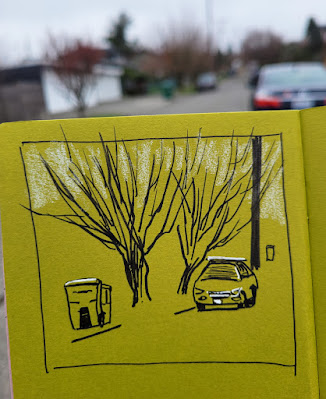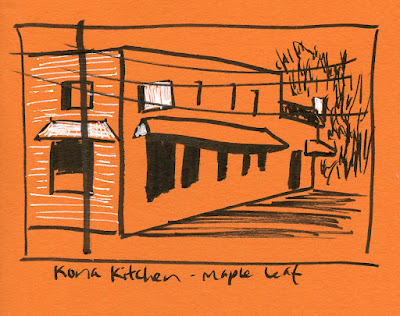 |
| 1/26/23 Trash day, Maple Leaf neighborhood |
Please indulge me while I rant:
Anyone who has read my blog for longer than a minute knows
that I am a process-oriented artist. I enjoy thinking about and writing about
what is going on in my mind as well as on the paper as I draw. More importantly,
I learn from that kind of thinking and writing, so my process is both
purposeful and motivating. Documenting that process is the primary purpose of this
blog.
If you follow a lot of artists on Instagram or other social
media, you know that producing “process” videos is a thing. A big thing.
Apparently artists are under enormous pressure to post such videos because the
almighty algorithm favors them, garnering more followers and likes.
Call me
old-fashioned, but I have an attention span longer than three seconds. Reducing
an hour of work to a few seconds of jittery, frenetic, time-lapse travesties,
these videos often do not even reward the viewer with a still image of the
finished work at the end – it just instantly repeats! That is no way to view
art. It is also taking a presumably relaxing, enjoyable, even meditative
process and making it look like an epileptic seizure.
These videos have nothing
to do with “process,” since the viewer is not privy to the thinking behind
whatever convulsive behavior we are seeing the artist’s hand and pen or brush doing.
We might be able to guess a choice that was made, based on what we saw in a
flash now long gone, but we can’t go back to consider it, because on Instagram,
you can’t rewind – you can only start over and hope that you pause at the right
moment (not that I have ever bothered). When I know a video like that is
beginning, I scroll right past. And if an artist posts nothing but videos like
that, I stop following.
By contrast, Instead of a “process” video, Matt Gibbons recently posted a still image of a lovely painting. I would have enjoyed
simply viewing it at my leisure, but he also gave me three sentences describing
his intention, how he tried to execute it, possibly less successfully than he
had wanted, and a concluding thought. I’m guessing that writing those three
sentences took less time and effort than setting up lights and a phone over a
desk to produce a time-lapse video. Understanding his process enhanced my
appreciation for his painting tenfold (even if I didn’t agree with his
assessment that it wasn’t quite successful), and I also learned from it.
He does occasionally post time-lapse videos, but they are
tolerable because they are few and far between his other posts of fresh,
delightful sketches (many of which are done on disposable coffee cups!).
I guess it’s not a thing, but I wish more artists would take
a moment to write a sentence or two about what they were thinking when they
made the work. I will always stop to read and view more closely. And what a
bonus if I learn from it!
End of rant.
Ironically, I have no process thoughts to share about today’s
sketch, which was made on trash day. As I sketched, a collection truck came by
to pick up these cans, and I saw the pressure the collectors are under to work
quickly, a line of cars stacked up behind their truck. My only thoughts were of
appreciation for this service that we usually take for granted (until the service isn’t there).






















































